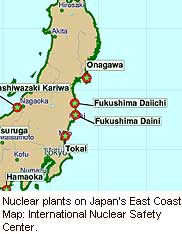- Skip Storing This Everyday Product in the Fridge Door
- Green Tea + B3 Pairing May Boost Brain Health
- Navigating Your Midlife Crisis: Embracing New Possibilities
- City Raccoons Showing Signs of Domestication
- Mapping the Exposome: Science Broadens Focus to Environmental Disease Triggers
- One Week Less on Social Media Linked to Better Mental Health
- Your Brain Changes in Stages as You Age, Study Finds
- Some Suicide Victims Show No Typical Warning Signs, Study Finds
- ByHeart Formula Faces Lawsuits After Babies Sickened With Botulism
- Switch to Vegan Diet Could Cut Your Greenhouse Gas Emissions in Half
Ocean Plume from Japan Nuke Disaster Will Reach U.S. by 2014


FRIDAY, Aug. 30Within three years of the Fukushima nuclear plant meltdown that was triggered by a tsunami in Japan in March 2011, the radioactive ocean plume resulting from the disaster will reach the shores of the United States, researchers say.
However, according to the Australian Research Council’s Centre of Excellence for Climate System Science, by the time the plume hits the west coast of the United States it is expected to be harmless.
“Observers on the west coast of the United States will be able to see a measurable increase in radioactive material three years after the event,” Erik van Sebille, one of the paper’s authors, said in a news release from the research council.
“However,” he added, “people on those coastlines should not be concerned, as the concentration of radioactive material quickly drops below World Health Organization safety levels as soon as it leaves Japanese waters.”
Within four months of the incident, two currents off the coast of Japan, known as the Kuroshio Current and the Kurushio Extension, diluted the radioactive material to levels considered safe by the WHO, the authors of the report said.
Although atmospheric radiation was detected on the west coast of the United States within days of the nuclear disaster, the researchers said radioactive particles in the ocean plume take much longer to travel. Using various ocean simulations to track the path of the radiation, scientists plotted where the radioactive particles would likely move through the Earth’s oceans over the next decade.
The study authors added that eddies, giant whirlpools and other currents in the open ocean accelerate this dilution process and will ultimately disperse radioactive particles along the west coast.
“Although some uncertainties remain around the total amount released and the likely concentrations that would be observed, we have shown unambiguously that the contact with the north-west American coasts will not be identical everywhere,” researcher Vincent Rossi said in the news release.
“Shelf waters north of 45 degrees north will experience higher concentrations during a shorter period, when compared to the Californian coast,” Rossi said. “This late but prolonged exposure is due to the three-dimensional pathways of the plume. The plume will be forced down deeper into the ocean toward the subtropics before rising up again along the southern Californian shelf.”
The research, published online Aug. 28 in Deep-Sea Research 1, predicts that most of the radioactive material from the disaster will remain in the North Pacific, and only a small amount will move south of the Equator within 10 years of the incident. Eventually, the researchers said, a harmless amount of the radiation will spread into other waters, including the Indian and South Pacific oceans.
“Australia and other countries in the Southern Hemisphere will see little if any radioactive material in their coastal waters and certainly not at levels to cause concern,” van Sebille said.
More information
The U.S. Environmental Protection Agency provides more information on Fukushima radiation monitoring.
Source: HealthDay
Copyright © 2025 HealthDay. All rights reserved.










